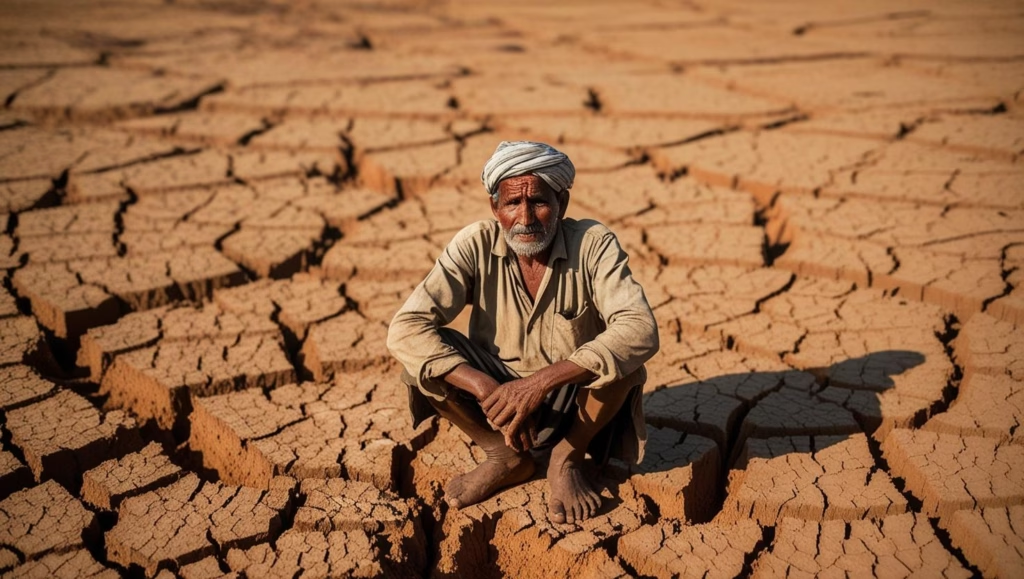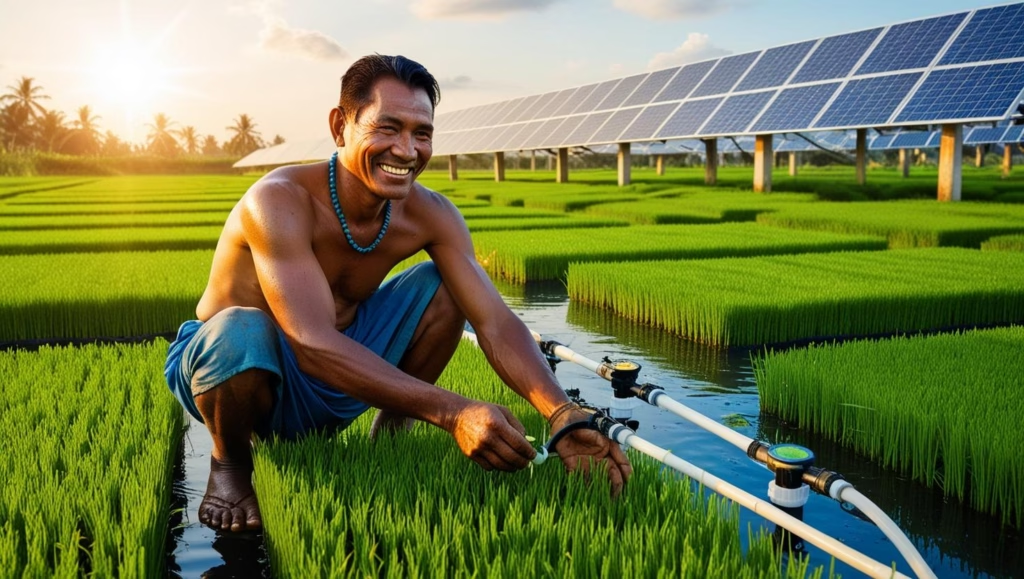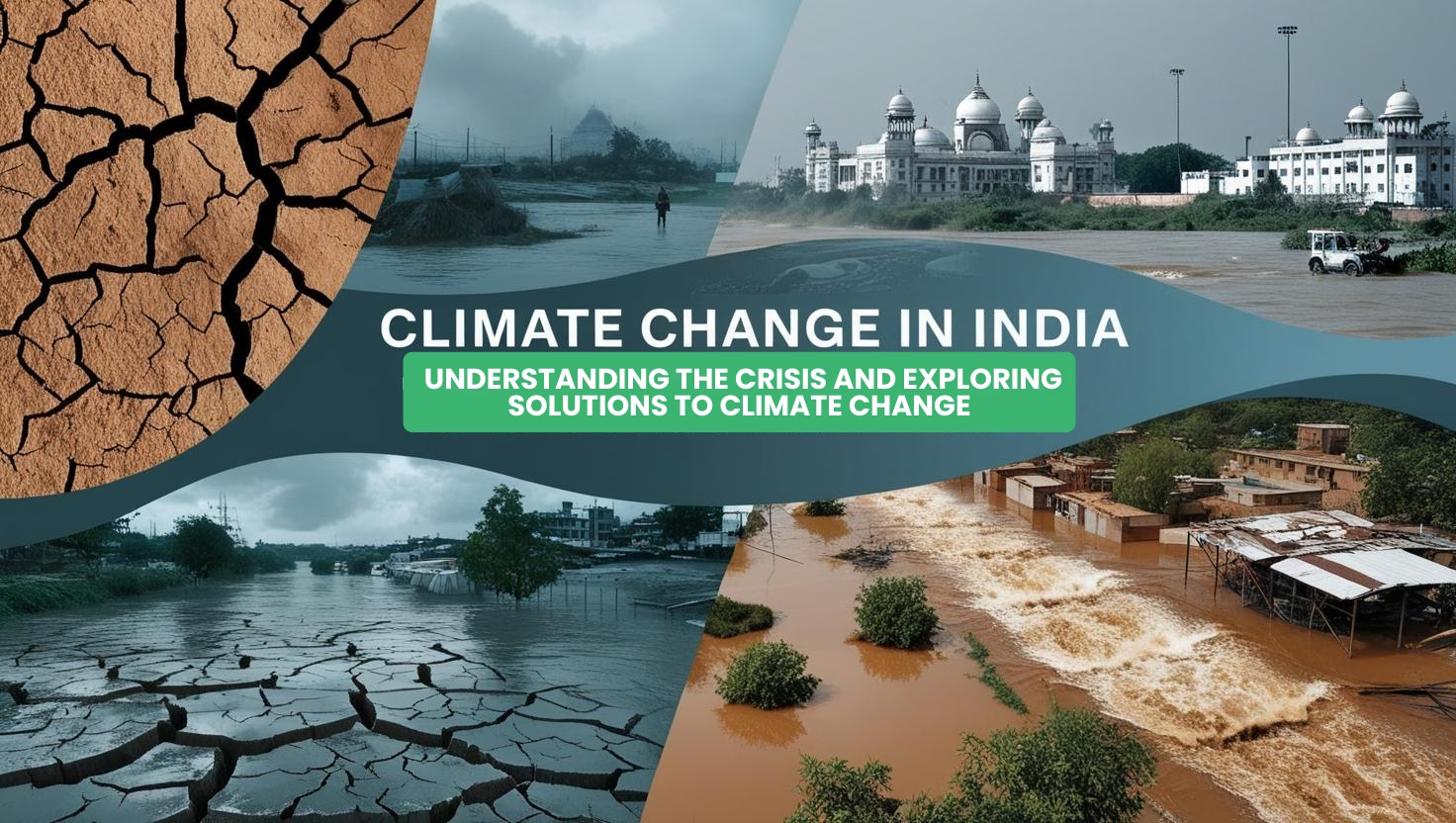Introduction:
India, home to 140 crore people, stands at the front lines of the global climate crisis. With Himalayan glaciers melting, erratic monsoons, and severe heatwaves, climate change in India is no longer a distant threat – it is a stark reality. As the world’s third-largest carbon emitter, India faces a dual challenge: balancing rapid development with sustainable practices. This blog dives into the severe impacts of climate change in India and highlights scalable solutions to climate change that can protect communities and ecosystems.
Table of Contents
Significance:
Demographic Weight:
India’s 140 crore (1.4 billion) population amplifies the risks—where climate impacts affect a large population’s livelihoods, health, and food security.
Geographical Risks:
India is located in a climate-sensitive region and faces challenges like rising sea levels, tropical cyclones, and the collapse of Himalayan ecosystems.
Economic Dependence:
Over 50% of Indians rely on climate-vulnerable sectors like agriculture, fisheries, and forestry, making the economy highly vulnerable to climate shocks.
Immediate Climate Impact:
Melting Himalayan Glaciers:
The Himalayas, also known as the “Third Pole“, supply water to rivers like the Ganges, Yamuna, and Brahmaputra, which supply water to 60 crore people. Glacier retreat threatens freshwater availability, hydropower, and agriculture.
The International Centre for Integrated Mountain Development (ICIMOD) reports that if emissions remain unchecked, the Himalayas may lose up to 75% of their glaciers’ ice by 2100. According to another study, Himalayan glaciers have lost 10% of their ice in 40 years.
Uncontrolled Monsoon:
The monsoon irrigates 60% of India’s agricultural land, and agriculture is the main source of livelihood for about 50% of India’s population. Unpredictable rainfall disrupts crop cycles, posing a risk to food security and farmers’ incomes.
In 2023, the monsoon season received 110% of the rainfall in July but was 36% deficient in August, leading to floods in Punjab (faced 150% more rain) and drought in Jharkhand (46% rain deficit).

Severe Heatwaves:
Due to severe heatwaves cities like Delhi, Hyderabad, Mumbai, and Chennai are now enduring temperatures above 45 degrees Celsius, leading to heatstroke deaths (in 2023, 100 deaths were due to severe heatwaves in Maharashtra alone), reduced labour productivity (according to the report of International Labour Organization (ILO), outdoor workers lose 2-3 hours productivity daily during heatwaves, costing $78 billion annually), and strain on the power grid. These cities now endure 5–8 more heatwave days annually than in the 1990s, a clear consequence of climate change in India. In 2022, India experienced the hottest March in 122 years. The India Meteorological Department (IMD) has observed a 30% increase in the frequency of heatwaves since 1990.
Coastal Vulnerability:
Rising sea levels (3.3 mm per year along India’s coast, MoES) due to climate change in India, along with intense cyclones like Amphan (2020) and Toukate (2021) caused $14 billion in damage, are ravaging India’s 7,500 km of coastline, creating an immediate crisis: salinity from seawater intrusion into the Sundarbans is damaging agricultural land and freshwater and forcing mass migration, putting more than 3.5 crore coastal residents at risk of displacement by 2050. On the other hand, Mumbai, which contributes approximately 6% of India’s GDP – faces the risk of flooding that threatens the financial hub, trade networks, and urban infrastructure.
India’s Dual Challenge: Development vs. Sustainability
Understanding the Dual Challenge:
Development Imperatives:
Now, India is one of the fastest-growing economies in the world. It aims to lift millions of Indians out of poverty as quickly as possible, improve infrastructure, and provide energy to its 140 crore people. India’s crucial growth sectors are manufacturing, urbanization, transportation, and energy production.
Sustainability Imperatives:
Climate change in India is a critical issue, as the country is the world’s third-largest emitter of greenhouse gases. Efforts to combat this challenge focus on reducing emissions by transitioning energy production from fossil fuels to renewable energy sources like solar and wind. This aligns with its ambitious target of 500 GW renewable capacity by 2030. Along with this, protecting the fragile ecosystem is vital to preserve water security, biodiversity, and carbon sinks. The sustainability imperatives are not just environmental but economic and social necessities, securing livelihoods, health, and India’s role in achieving global climate goals.
Reasons Behind Dilemma:
Energy Demand:
According to the IEA (International Energy Agency), India’s energy consumption is set to double by 2040. Currently, the main source of energy is coal, which provides about 70% of India’s electricity. Coal is cheap and abundant but highly polluting.
Fairness and Responsibility:
Although India accounts for 7% of global emissions, its per capita emissions are low (1.8 tons versus the US’s 14.7 tons). However, its overall emissions are significant due to its large population.
Key Areas of Conflict:
Coal vs. Renewable Energy:
Dependency on Coal:
India has 4th largest coal reserves in the world. Many people especially in states like Jharkhand and Chhattisgarh depend on coal mining for their livelihoods.
Renewables Push:
Despite the ambitious target of 500 GW renewable capacity by 2030, challenges like land acquisition, grid instability, and financing slow progress.
Agricultural Pressure:
Use of Fertilizer:
The use of chemical fertilizers boosts production but degrades the social quality and increases toxic emissions.
Water-Intensive Crops:
Crops like rice and sugarcane are water-intensive crops, consume 80% of India’s freshwater, and contribute to methane emissions
Transportation Boom:
Growth in Auto Industry:
India is the 3rd largest auto market after the US and China. Petrol/Diesel vehicles worsening urban air pollution.
Hurdles in EV Adaptation:
Though EV is the future but there are some hurdles in adopting EVs i.e. high upfront costs, lack of charging facilities, and reliance on coal-powered electricity.
India’s Balancing Act: Policies and Progress (Solutions to Climate Change):
National Commitments:
India’s Panchamrit (five nectar) goals, announced at COP26 (2021), are five ambitious climate targets. Those are as follows:
- 500 GW non-fossil energy capacity by 2030;
- 50% of total energy needs from renewables by 2030;
- Reduce total projected carbon emission by one billion ton by 2030;
- Reducing carbon intensity by 45% by 2030 from the level in 2005;
- Net-zero emissions by 2070.
Renewable Energy Successes:
Solar Power:
Installed capacity surged from 20 GW in 2018 to approximately 100 GW in 2024, highlighting India’s rapid transition towards renewable energy. This shift is a crucial aspect of addressing climate change in India, where rising temperatures and environmental concerns necessitate sustainable solutions. Projects like Gujarat’s Dholera Solar Park and Rajasthan’s Bhadla Solar Park (one of the world’s largest solar energy production farms, generating 2.25 GW of clean energy) serve as global benchmarks in clean energy innovation.
Green Hydrogen:
Aims to produce 5 million tons/year of green hydrogen by 2030 to decarbonize industries.
Sustainable Urbanization:
Smart Cities’ mission promotes energy-efficient buildings, public transport, and waste management in 100 cities.
Reforms In Agriculture:
PM-KUSUM Scheme:
Under the Pradhan Mantri Kisan Urja Suraksha evam Utthan Mahabhiyan (PM-KUSUM), the government incentivizes solar pumps and grid-connected solar farms to replace diesel-powered irrigation.
Natural Farming:
States like Andhra Pradesh and Sikkim promote chemical-free farming to cut emissions and improve soil health.

Afforestation and Biodiversity Conservation:
The Green India Mission targets to restore 26 million hectares of land by 2030. Kerala’s community-led project “Pachathuruthu” (Green Islands) show the power of local action.
Conclusion:
India faces a critical battle against climate change in India, with severe impacts such as melting glaciers, erratic monsoons, heatwaves, and more, disrupting lives, economies, and ecosystems. As the world’s third-largest emitter and home to a billion people – half of whom rely on climate-sensitive agriculture – India must balance the transition to a low-carbon future with the security of its population. Key solutions include its renewable energy revolution and climate-smart agriculture, such as natural farming in Andhra Pradesh. Challenges remain: phasing out coal while ensuring access to energy, securing global climate finance, and scaling up green technologies (hydrogen, carbon capture).
India’s COP26 Panchamrit goals to net zero by 2070 rely on equitable financing, innovation, and grassroots resilience efforts, such as Kerala’s Green Islands and Chennai’s rainwater harvesting. Climate change in India is particularly threatening to coastal cities like Mumbai, Chennai and Himalayan water security face existential risks, yet India’s demographic strength, renewable potential, and traditional knowledge offer hope.
The call for collective action calls on governments to enforce emissions regulations, industries to embrace the circular economy, and citizens to embrace sustainability (reduce plastic, conserve water). Addressing climate change in India is not just an environmental necessity but a moral duty to future generations. Framing climate action as an opportunity, India can lead the Global South toward justice and environmental stewardship. The time to act is now – inaction risks catastrophic costs.


